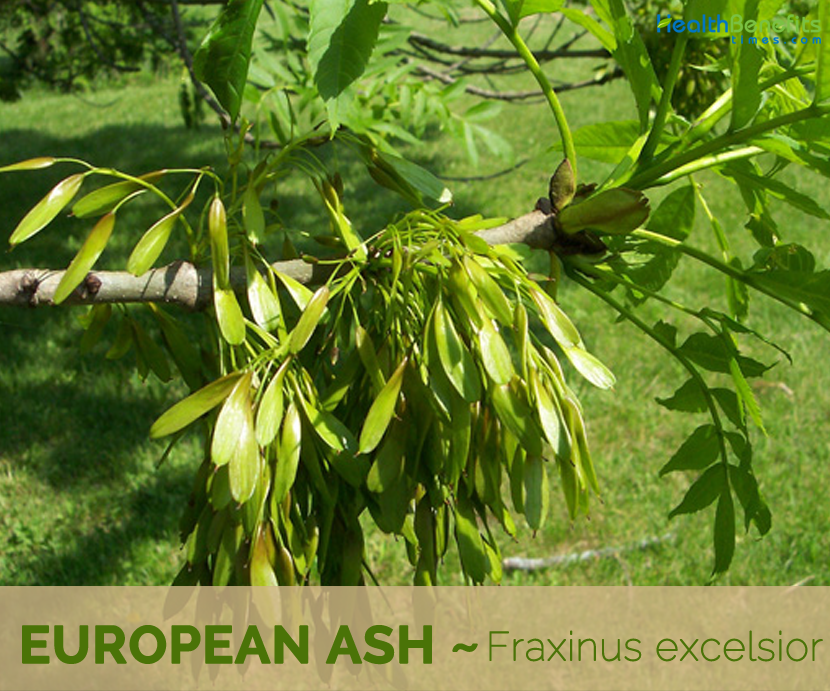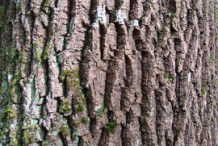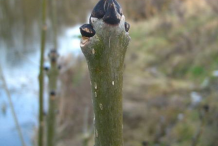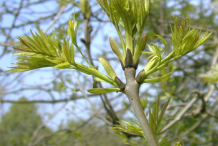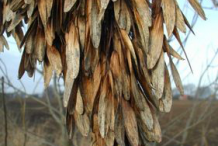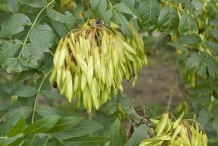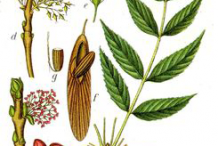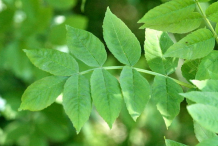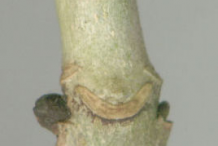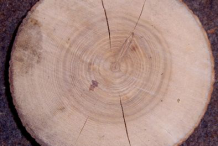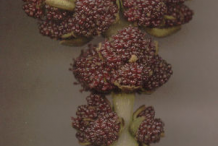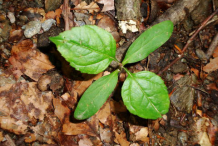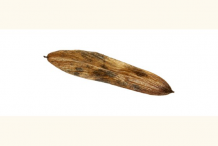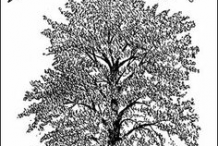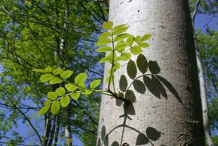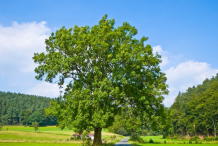Plant Description
European Ash is a large deciduous tree that grows about 20–35 m (66–115 ft.) (exceptionally to 46 m or 151 ft.) tall with a trunk up to 2 m (6.6 ft.) (exceptionally to 3.5 m or 11 ft.) Diameter, with a tall, domed crown. The bark is smooth and pale grey on young trees, becoming thick and vertically fissured on old trees. The plant is easily identified in winter by smooth shoots that are stout, greenish-grey, with jet black buds (which distinguish it from most other ash species, which have grey or brown buds). The branches of this tree do not have any hair or bristle and has a grayish-green hue.
Leaves
Leaves are 20–35 cm (7.9–13.8 in) long, pinnately compound, typically comprising 3-6 opposite pairs of light green, oval leaflets with long tips, up to 40cm long. The leaflets are 3–12 cm (1.2–4.7 in) long and 0.8–3 cm (0.31–1.18 in) broad. There is an additional singular ‘terminal’ leaflet at the end. The leaves can move in the direction of sunlight, and sometimes the whole crown of the tree may lean in the direction of the sun. Another characteristic of ash leaves is that they fall when they are still green. The leaves are often among the last to open in spring, and the first to fall in autumn if an early frost strikes; they have no marked autumn color, often falling dull green. Leaves are dark green in summer, changing to yellow green or a mild yellow in fall.
Flower
Female flowers being somewhat longer than the male flowers; they are dark purple, and without petals, and are wind-pollinated. Flowers appear before the leaves in spring, growing in spiked clusters at the tips of twigs. Both male and female flowers can occur on the same tree, but it is more common to find all male and all female trees; a tree that is all male one year can produce female flowers the next, and similarly a female tree can become male.
Fruit
Once the female flowers have been pollinated by wind, they develop into conspicuous winged fruits, or ‘keys’, in late summer and autumn. The inconspicuous springtime flowers are followed by clusters of winged fruits samara 2.5–4.5 cm (0.98–1.77 in) long and 5–8 mm (0.20–0.31 in) broad which turn brown and remain on the trees well after the leaves have fallen. They are dispersed by birds and mammals.
Traditional uses and benefits of European Ash
- Leaves are astringent, cathartic, diaphoretic, mildly diuretic, laxative and purgative.
- The have been used as a laxative, making a mild substitute for senna pods.
- Bark is antiperiodic, astringent and a bitter tonic.
- Little used in modern herbalism, it is occasionally taken in the treatment of fevers.
- Seeds, including their wings, have been used as a carminative.
- Distilled water of the leaves, taken every morning, was considered good for dropsy and obesity.
- Decoction of the leaves in white wine had the reputation of dissolving stone and curing jaundice.
- Leaves should be gathered in June, well dried, powdered and kept in well corked bottles.
- Leaves bark and young twigs contain coumarins (fraxin, esculin, and related substances) that inhibit the growth of bacteria and fungi.
- Ash is beneficial as a treatment for healing wounds and sores and to reduce swelling.
- Ash bark is used as a fever-reducing agent and as a substitute for quinine, which is derived from the quinine tree.
- Bark and leaves have been used traditionally as an herbal remedy for diarrhea.
- The substance fraxin found in the bark and the leaves has diuretic properties and may increase the excretion of uric acid.
- Bark help treat gout in the elderly and may also be beneficial for other rheumatic disorders, such as osteoarthritis and rheumatoid arthritis.
- Ailments associated with the bladder and kidneys are also treated with the bark.
- Additionally, it is used to remove stones in the urinary tract.
- Bark and the leaves of the ash tree may act as a mild laxative due to the presence of mannitol and can, therefore, be used as an herbal remedy for constipation and to eliminate intestinal parasites.
- Seeds of ash are also used to bring down fever as well as augment the appetite.
- Tincture prepared from the ash leaves is employed to augment sexual desire or libido in men.
- Distilled water of the ash leaves, taken every morning, was considered good for dropsy and obesity.
- Decoction of the ash leaves in white wine had the reputation of dissolving stone and curing jaundice.
Ayurvedic Health benefits of European Ash
- Urinary Tract Infections: Put one tbsp leaves in half cup of hot water and steep for 2-3 minutes. Strain and take one cup a day and a mouthful at a time.(Take unsweetened)
- Leprosy: Boil one tbsp of Fraxinus Excelsior bark in half cup water. Steep for just 2 minutes. Cool and drink unsweetened a mouthful at a time, half cup throughout the day. You may also improve the taste by adding some peppermint or marjoram.
- Anuria: Boil leaves of Fraxinus Excelsior. Prepare a decoction. Have a cup two times a day.
Culinary Uses
- Immature seed usually pickled by steeping in salt and vinegar, and then used as a condiment for other foods.
- Leaves are sometimes used as an adulterant for tea.
- Edible oil similar to sunflower oil is obtained from the seed.
Other Facts
- It was probably the most versatile wood in the countryside with wide-ranging uses.
- Until World War II the trees were often coppiced on a ten-year cycle to provide a sustainable source of timber for fuel and poles for building and woodworking.
- Color of the wood ranges from creamy white to light brown, and the heart wood may be a darker olive-brown.
- Because of its high flexibility, shock-resistance and resistance to splitting, ash wood is the traditional material for bows, tool handles, especially for hammers and axes, tennis rackets and snooker cue sticks and it was extensively used in the construction of early aircraft.
- Ash was commonly used green for making chair frames which would be seated with another timber or with woven rush.
- In Northumberland, crab and lobster pots (traps) sometimes known as ‘creeves’ by local people are still made from ash sticks.
- Because of its elasticity European Ash wood was commonly used for walking sticks.
- Light color and attractive grain of ash wood make it popular in modern furniture such as chairs, dining tables, doors and other architectural features and wood flooring.
- Green dye is obtained from the leaves.
- Ash does not flower until it has reached 30 years.
- Ash is the second most important wood used in aeroplanes.
- Ash bark is astringent and has been employed for tanning nets.
- Ash is valuable as firewood because it burns well even when ‘green’ (freshly cut).
Dosage and Administration
Herbalists sometimes recommend the following dosages.
As an infusion: One or two teaspoons of ground leaves to a cup of hot water. Steeped for 2 to 3 minutes and then strained. Drink one to two cups a day.
As a decoction: One teaspoon of bark powder to a cup of water. Boiled briefly and then steeped for 2 to 3 minutes. Drink one cup daily. For a more appealing taste add peppermint or sweet marjoram.
The leaves should be picked in early summer when they are glazed by a thin mucous membrane. Then, dried and stored in an airtight container.
Best is to collect the bark in the spring, then dry it and grind into a powder. The seeds should be harvested while they are young and green.
Precautions
- Poisonous to ruminants, it has also caused dermatitis in some people.
- Excess use may cause Allergic reactions.
- The safety of using ash in infants, pregnant women and nursing mothers as well as people suffering from kidney or liver ailments is yet to be ascertained.
References:
https://www.itis.gov/servlet/SingleRpt/SingleRpt?search_topic=TSN&search_value=502663#null
https://davesgarden.com/guides/pf/go/78424/
https://npgsweb.ars-grin.gov/gringlobal/taxonomydetail.aspx?id=282
http://www.pfaf.org/USER/Plant.aspx?LatinName=Fraxinus+excelsior
https://www.cabi.org/isc/datasheet/24522
https://www.botanical.com/botanical/mgmh/a/ash–073.html
http://www.theplantlist.org/tpl1.1/record/kew-369664
https://plants.usda.gov/core/profile?symbol=FREX80
https://en.wikipedia.org/wiki/Fraxinus_excelsior
https://www.arkive.org/ash/fraxinus-excelsior/
http://dendro.cnre.vt.edu/dendrology/syllabus/factsheet.cfm?ID=969
http://www.missouribotanicalgarden.org/PlantFinder/PlantFinderDetails.aspx?taxonid=282928
http://practicalplants.org/wiki/Fraxinus_excelsior
Comments
| European Ash Quick Facts | |
|---|---|
| Name: | European Ash |
| Scientific Name: | Fraxinus excelsior |
| Origin | Europe from Portugal to Russia, with the exception of northern Scandinavia and southern Iberia |
| Colors | Green turning to brown |
| Shapes | Samara 2.5–4.5 cm (0.98–1.77 in) long and 5–8 mm (0.20–0.31 in) broad, often hanging in bunches through the winter |
| Taste | Bitter, Astringent |
| Name | European Ash |
|---|---|
| Scientific Name | Fraxinus excelsior |
| Native | Europe from Portugal to Russia, with the exception of northern Scandinavia and southern Iberia. It is also considered native in southwestern Asia from northern Turkey east to the Caucasus and Alborz mountains |
| Common Names | Ash, European ash, common ash, weeping ash, bird’s tongue, American Ash, Biltmore Ash, Cane Ash, White Ash |
| Name in Other Languages |
Aragonese: Fraixin Unspecified: Fresnu, Wšědna jaseń |
| Plant Growth Habit | Tall, handsome deciduous tree |
| Growing Climate | Riverbanks, meadow and valley woodlands, and deciduous woodlands |
| Soil | Thrives best in fertile, deep clay, loam, sand, acidic, alkaline, well-drained alkaline soil. |
| Plant Size | 20–35 m (66–115 ft.) (Exceptionally to 46 m or 151 ft.) tall |
| Bark | Smooth and pale grey on young trees, becoming thick and vertically fissured on old trees |
| Trunk | 2 m (6.6 ft.) (Exceptionally to 3.5 m or 11 ft.) diameter |
| Twigs | Stout, gray brown, leaf scar narrow u-shaped, buds pubescent, very dark (essentially black). |
| Leaf | 20–35 cm (7.9–13.8 in) long, pinnate compound, with 7-13 leaflets, the leaflets 3–12 cm (1.2–4.7 in) long and 0.8–3 cm (0.31–1.18 in) broad, sessile on the leaf rachis, and with a serrated margin |
| Flowering Periods | April and May |
| Flower | Female flowers being somewhat longer than the male flowers; they are dark purple, and without petals, and are wind-pollinated. |
| Fruit Shape & Size | Samara 2.5–4.5 cm (0.98–1.77 in) long and 5–8 mm (0.20–0.31 in) broad |
| Fruit Color | Green turning to brown |
| Flavor/aroma | Odorless |
| Taste | Bitter, Astringent |
| Plant Parts Used | Leaves, bark, seeds |
| Season | Sep to January |
| Varieties/ Types |
|
| Lifespan | Normal age around 200 years, but there are some trees that are older than 500 years. |


